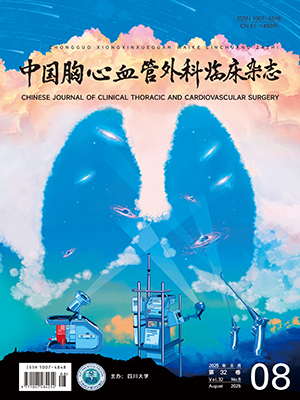| 1. |
Benjamin EJ, Blaha MJ, Chiuve SE, et al. Heart disease and stroke statistics-2017 update: A report from the American Heart Association. Circulation, 2017, 135(10): e146-e603.
|
| 2. |
Canet J, Gallart L, Gomar C, et al. Prediction of postoperative pulmonary complications in a population-based surgical cohort. Anesthesiology, 2010, 113(6): 1338-1350.
|
| 3. |
Deng QW, Tan WC, Zhao BC, et al. Intraoperative ventilation strategies to prevent postoperative pulmonary complications: A network meta-analysis of randomised controlled trials. Br J Anaesth, 2020, 124(3): 324-335.
|
| 4. |
Strosing KM, Faller S, Gyllenram V, et al. Inhaled anesthetics exert different protective properties in a mouse model of ventilator-induced lung injury. Anesth Analg, 2016, 123(1): 143-151.
|
| 5. |
de la Gala F, Piñeiro P, Reyes A, et al. Postoperative pulmonary complications, pulmonary and systemic inflammatory responses after lung resection surgery with prolonged one-lung ventilation. Randomized controlled trial comparing intravenous and inhalational anaesthesia. Br J Anaesth, 2017, 119(4): 655-663.
|
| 6. |
Uhlig C, Bluth T, Schwarz K, et al. Effects of volatile anesthetics on mortality and postoperative pulmonary and other complications in patients undergoing surgery: A systematic review and meta-analysis. Anesthesiology, 2016, 124(6): 1230-1245.
|
| 7. |
O'Gara B, Talmor D. Perioperative lung protective ventilation. BMJ, 2018, 362: k3030.
|
| 8. |
Ji Q, Mei Y, Wang X, et al. Risk factors for pulmonary complications following cardiac surgery with cardiopulmonary bypass. Int J Med Sci, 2013, 10(11): 1578-1583.
|
| 9. |
von Elm E, Altman DG, Egger M, et al. The Strengthening the Reporting of Observational Studies in Epidemiology (STROBE) statement: Guidelines for reporting observational studies. Lancet, 2007, 370(9596): 1453-1457.
|
| 10. |
Landis RC, Brown JR, Fitzgerald D, et al. Attenuating the systemic inflammatory response to adult cardiopulmonary bypass: A critical review of the evidence base. J Extra Corpor Technol, 2014, 46(3): 197-211.
|
| 11. |
Yu QB, Li HM, Li LL, et al. Sevoflurane downregulates interleukin-6 and interleukin-8 levels in patients after cardiopulmonary bypass surgery: a meta-analysis. Genet Mol Res, 2015, 14(4): 19016-19027.
|
| 12. |
Balogh AL, Peták F, Fodor GH, et al. Sevoflurane relieves lung function deterioration after cardiopulmonary bypass. J Cardiothorac Vasc Anesth, 2017, 31(6): 2017-2026.
|
| 13. |
Engelman DT, Ben Ali W, Williams JB, et al. Guidelines for perioperative care in cardiac surgery: Enhanced Recovery After Surgery Society recommendations. JAMA Surg, 2019, 154(8): 755-766.
|
| 14. |
Bonanni A, Signori A, Alicino C, et al. Volatile anesthetics versus propofol for cardiac surgery with cardiopulmonary bypass: Meta-analysis of randomized trials. Anesthesiology, 2020, 132(6): 1429-1446.
|
| 15. |
黑飞龙, 朱德明, 侯晓彤, 等. 2016年中国心脏外科手术和体外循环数据白皮书. 中国体外循环杂志, 2017, 15(2): 65-67.
|
| 16. |
Ozdogan HK, Cetinkunar S, Karateke F, et al. The effects of sevoflurane and desflurane on the hemodynamics and respiratory functions in laparoscopic sleeve gastrectomy. J Clin Anesth, 2016, 35: 441-445.
|
| 17. |
Klock PA, Czeslick EG, Klafta JM, et al. The effect of sevoflurane and desflurane on upper airway reactivity. Anesthesiology, 2001, 94(6): 963-967.
|




